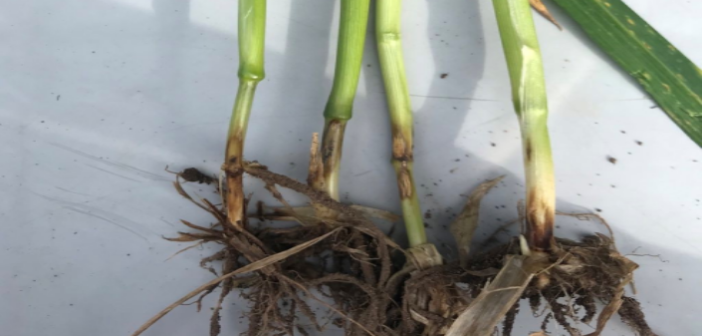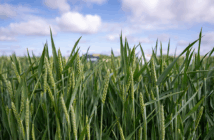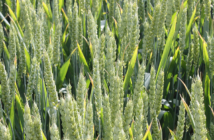Eyespot is a common soil-borne disease in intensive cereal rotations and as wet weather aids its early development, the high rainfall that crops have experienced so far this season makes it a disease worth checking for this spring.

Professor Rumiana Ray
Professor Rumiana Ray, a Plant Pathologist at the University of Nottingham said, “In the field, growers can monitor their crops for eyespot around GS 30/31 by pulling plants up to look at the lower stem bases for the appearance of eyespot lesions. These initially show on the outer leaf sheaths, penetrating through these, and onto the stem by GS39. Lesions manifest as honey-brown smudges, later forming the distinct eye-shape with dark edges and pupil in the middle.”
“Once eyespot lesions have established on the stem, they become severe by early summer. During crop flowering the pathogens block and digest the vascular tissues in the stem, affecting the movement of nutrients and water to the ear. Severe disease during grain filling leads to partially empty ears manifesting as whiteheads scattered in fields. Sporadically, lodging may occur when plant stems break at the point of the lesion because stems are unable to support the weight of the ear.”
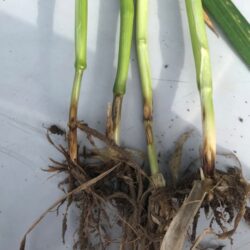
In terms of yield losses, these are likely to be around 10%, and up to 30% in a bad year with a very susceptible cultivar or where chemical control has not been effective. The disease can cause severe reductions in grain quality, so thousand grain weight and specific weight will be affected,” said Prof. Ray.
There are two pathogenic fungal species which cause eyespot, Oculimacula yallundae known as the W type with isolates that are more pathogenic to wheat than other cereals, and O. acuformis as the R type with isolates being equally pathogenic to cereal species. In England, since 2012 there seems to be an equal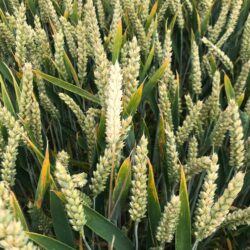 distribution of these two species in fields, both of which can overwinter on stubble, trash, grass weeds and volunteers.
distribution of these two species in fields, both of which can overwinter on stubble, trash, grass weeds and volunteers.
Importance of weather for disease development
Rainfall
“The fungi surviving on plant residues produce spores which are spread by rain splash onto the coleoptile of young seedlings. The spores germinate and penetrate the coleoptile forming mycelial plaques on the developing plant. High rainfall over the winter period (November to December), as has been the case this season, can favour spore dispersal to new plants and pathogen infection.
The amount of rainfall in spring (February to May) is also important, as rainfall events favour the development and establishment of severe lesions on the developing stems, with the pathogen penetrating successive leaf sheaths, forming the typical eye shaped lesions which we first see clearly around GS31 and by GS 39-59 these lesions can take over the full circumference of the stem,” said Prof. Ray.
Temperature
The eyespot fungi can develop at low temperatures, however, infection will be affected negatively by very high temperatures as we move towards spring and summer.
“Hot weather causes plants to develop faster and to lose the outer leaf sheaths on the stem more rapidly. If lesions are establishing at this time, then the source of inoculum on the leaf sheaths will be lost and so the pathogens will be unable to remain on the host,” explained Prof Ray.
AHDB Risk Assessment
“This is a two-step risk assessment, combining a score for pre-sowing risk and an assessment of the percentage eyespot present in the spring which helps to pinpoint high risk crops and indicates whether chemical control will be necessary,” said Scott Milne, Agronomy Manager BASF.
Factors considered in the risk assessment:
- Geographical area and soil type
Mr Milne said, “Westerly locations are generally considered higher risk because of their high rainfall. This season is likely to be considered higher risk across the whole country, this high rain also means all soils types are at higher risk in 2024.”
- Rotation and weeds
“A previous crop of wheat presents the highest risk and a break crop the lowest. Volunteers and grasses can also act as hosts for the eyespot pathogens.”
- Variety
“The resistance gene to eyespot, Pch1 is now bred into many new varieties, with the AHDB indicating on the Recommended List (RL) which varieties carry this gene, however, nearly 60% of the winter wheat varieties on the RL were assessed as 5 or less for eyespot.”
- Cultivation
“In the risk assessment, ploughing carries risk for eyespot, with higher risk given to ploughing than min till.”
- Sowing date
“An earlier sowing date gives longer exposure to the eyespot fungi and so is higher risk.”
- Fertility
“Lush crops are more prone to eyespot so growers should adhere to fertiliser guidelines for their crops.”
Chemistry for eyespot control
Last season, Prof. Ray carried out a trial in conjunction with BASF, looking at the effect of different chemical controls applied at T1, the key timing for eyespot control.
The trial was in a field of KWS Zyatt which was established by min till. It was a naturally infected site and most of the eyespot was found to be associated with the R type pathotype although there was a mixed population of both eyespot pathogens.
Prof. Ray said, “We had an early natural infection with high eyespot incidence, and we ended up with moderate eyespot.”
Disease severity was assessed at GS 69 and treated plots were compared to the untreated.
“We did not expect severe disease on KWS Zyatt as it carries the resistance gene Pch1, however the application of Revystar XE at 0.75 l/ha still gave a 23% reduction of eyespot disease index which was significantly different from the untreated.”
Jared Bonner, Business Development Manager BASF said, “Growers can be assured that a Revystar XE programme will deliver a good level of eyespot control. What we would say is don’t compromise your main disease programme to chase eyespot. Septoria and yellow rust are still the main drivers of wheat fungicide programmes in the UK. In Prof. Ray’s trial, Revystar XE was at least as good as the other treatments meaning you do not have to move to a prothioconazole based programme if you are worried about eyespot. Revystar XE, with its two effective active ingredients of Xemium and Revysol is doing a good job on eyespot.”
For more information on Revystar® XE, please visit our website.

